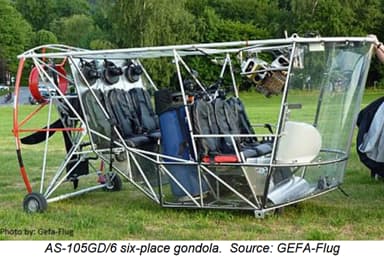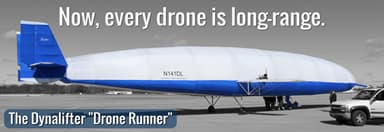Airships had largely moved on from bulk passenger transport, and long-range military surveillance by the dawn of the 21st century. Fast jet planes and orbital satellites dictated new roles for the largest cargo vessels we may ever see.
Their role would shift to heavy lifting, and large cargoes to remote places. They would be able to remain aloft for weeks, and this would attract new investors. The world’s oldest aircraft technology would gradually become less dependent on the human factor. Someday, not far away they might even find a role in space colonization.
CargoLifter AG CL 16 Project Abandoned 2002
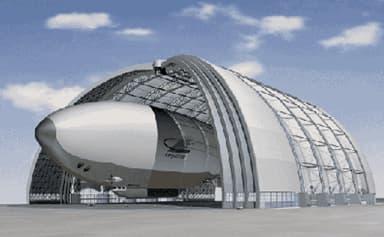
https://science.howstuffworks.com/transport/flight/future/cargolifter.htm
The CargoLifter AG CL 16 project kicked off in Wiesbaden, Germany in September 1996. The company planned to transport heavy and outsized loads directly from origin to destination weighing up to 160 tons.
The hangar in the image above at a former Soviet Air Force base was a technological innovation in itself. It measured 1180 ft x 720 ft x 348 ft high, and was large enough to enclose the Louisiana Superdome or the Eiffel Tower on its side.
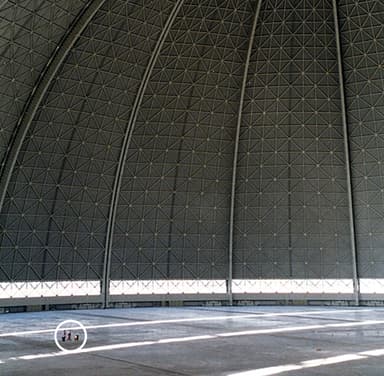
https://en.wikipedia.org/wiki/File:Brand_Cargolifter_Halle_innen.jpg
The overall specification for the CargoLifter AG CL 16 was:
- Envelope: Proprietary airtight, multi-layered, sixteenth inch thick film resembling rubberized fabric, capacity 19 million cu ft
- Nose Cone 85 feet diameter, featuring maneuvering engines and equipment for tethering to a tower
- Aluminum Keel 820 ft x 49 ft x 33 ft high, supporting operating, loading, and maneuvering systems
- Tail Unit 243 ft wide, comprising 4 steering fins with rudders each 138 ft long and 72 feet high
- 16 Turbine engines, capable of achieving 90 mph average cruising speed, and 6,200 miles before refueling.

https://science.howstuffworks.com/transport/flight/future/cargolifter.htm
CargoLifter built two smaller testing / demonstrating prototypes, and one was filled with helium and displayed outside the hangar. However, it went into liquidation in 2004 despite interest from Boeing and Heavy Elevator Canada. All that remains is the giant hangar, now morphed into the Tropical Islands theme park in the former Brand-Briesen Airfield in Halbe.
HiSentinal Stratospheric Airship (2005)
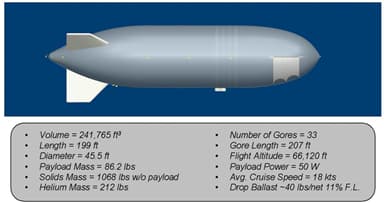
https://www.researchgate.net/figure/HiSentinel80-physical-properties_fig3_268571750
Remote control stratospheric airships fly at very high altitudes replicating services provided by satellites to some extent. A team headed by Southwest Research Institute SwRI successfully demonstrated powered flight at an altitude of 74 000 feet.
However, unlike conventional airships HiSentinel launched from Roswell N M with the hull only partly filled with helium and in a semi-flaccid condition. But it expanded to achieve its fully rigid airship shape as it rose, and the atmospheric pressure reduced around it.
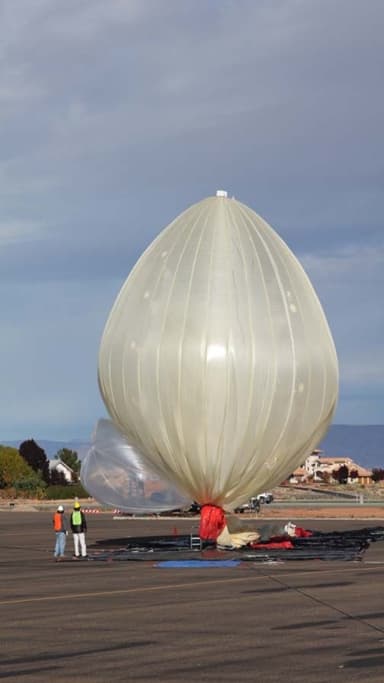
http://stratocat.com.ar/fichas-e/2010/PAG-20101110.htm
The design of HiSentinel allowed launch from remote sites not requiring large hangars and launch crews. The airship carried a 60-pound equipment pod and propulsion system for five hours. This made it the second airship in history to achieve powered flight in the stratosphere.
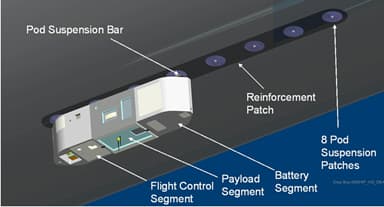
https://www.researchgate.net/figure/Equipment-pod-configuration-and-3-pod-Flight-Control-Payload-and-Battery-sections_fig4_268571750
American Blimp Corporation MZ-3A (2005)
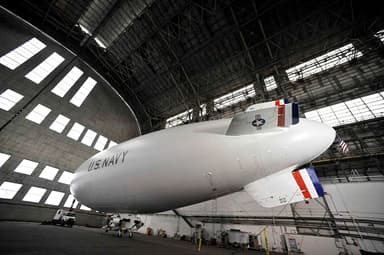
https://en.wikipedia.org/wiki/File:111026-N-JF840-032.jpg
American Blimp MZ-3A is a modified A-170 series built by American Blimp Corporation forUnited States Navy. The military acquired it in 2005, but it only began service in 2006 after fitting advanced research-and-development and science-and-technology equipment.
The specification is as follows:
- Length 178 feet, payload capability 2,500 lb
- Propulsion 2 x 80 hp Lycoming engines
- Performance maximum cruise speed of 60 mph
- Endurance 12 hours aloft and stationery

https://en.wikipedia.org/wiki/File:US_Navy_100708-N-9174G-003_A_U.S._Navy_MZ-3A_manned_airship_derived_from_the_commercial_A-170_series_blimp_lands_at_Lake_Front_Airport,_New_Orleans,_La.,_to_provide_logistical_support_for_the_Gulf_of_Mexico_oil_spill.jpg
MZ-3A commenced work at Naval Air Engineering Station Lakehurst, New Jersey in May 2006. Operations ceased in 2007 and she entered storage. Then, in October 2009 she transferred to the United States Naval Research Laboratory Military Support Division’s Scientific Development Squadron One (VXS-1). This was formerly known as the Flight Support Detachment, and located at Naval Air Station Patuxent River, Maryland.
The airship recommenced operations in March 2010 for testing. However, on July 5 that year she was redeployed to Jack Edwards National Airport in Gulf Shores, Alabama to assist in the Deepwater Horizon oil spill recovery operation.
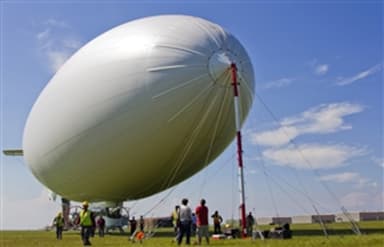
https://dod.defense.gov/OIR/gallery/igphoto/2001249464/
American Blimp MZ-3A was then provisionally suspended from future work, but reprieved in March 2012. She spent some time as a C4ISR (command, control, communications, computers, intelligence, surveillance, and reconnaissance) demonstrator in Florida.
The blimp was finally grounded permanently in October 2017, and sold by the Navy to Florida-based AirSign Airship Group. At that time she was the last airship operated by the U.S. military.
GEFA-Flug Six Seat Airship AS-105GD/6 (2006)
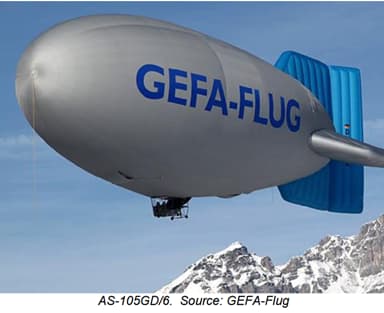
https://lynceans.org/wp-content/uploads/2019/08/GEFA-Flug-thermal-airships-converted.pdf
GEFA-Flug has been developing thermal airships since 1980 for advertising campaigns, promotional tours and pilot training. The broad design details are as follows:
- Several fabric bulkheads divide the hot air envelope into sections performing a similar role to helium gas cells in rigid airships
- Burners in the fore and aft direct heat to the different sections. Adjusting the relative flows enables the pilot to trim the airship.
- The vessel has night flying certification, and meets requirements for traveling through controlled airspace.
Development of a six-seater model commenced in 2006, with trial approval obtained in August 2008 from European Union Aviation Safety Agency EASA. The conversion involved scaling up the existing four-seater model to accommodate an additional two persons.
The specification of model GD/6 is as follows:
- Length 160 ft, diameter 49 ft, volume 176,500 cu ft, max weight 3,280 lb
- Propulsion Rotax 582 / 65 hp 2-Stroke, airspeed 22 mph, endurance 2 hrs
The vessel has a payload of 992 pounds, and is intended for commercial passenger transport, scientific projects, and tourist expeditions. It uses a combination of illumination inside the hull, and gas burners as night lights. This unusual combination saves energy while promoting a brand.
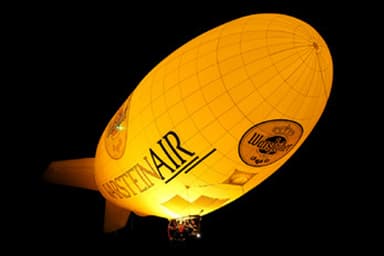
https://www.airplane-pictures.net/manufacturer.php?p=1209
Skyacht Aircraft, Inc. Personal Blimp Thermal Airship (2006)
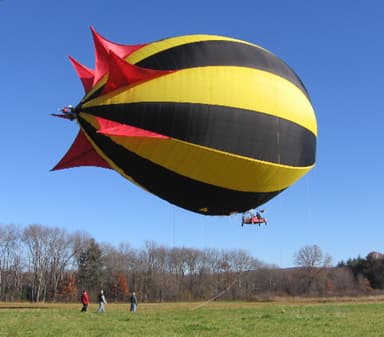
http://www.personalblimp.com/images.html
Humans imagined drifting like birds in the thermals, and soaring like eagles far above in the beginning of dreams of flight. Daniel Nachbar’s and John Fabel’s Personal Blimp stands out as an example of lighter-than-air flight for fun.
The most important aspect of their invention is the foldable envelope for storage and transportation. The strength lies in the flexible ribs held in sleeves inside the hull. An internal tension line controls expansion, and helps achieve a shape roughly that of an American style football.
Or, as the inventors describe it ‘A pair of gigantic umbrellas pointing in opposite directions, with their ribs running continuously and the handles of the umbrellas hooked together.”
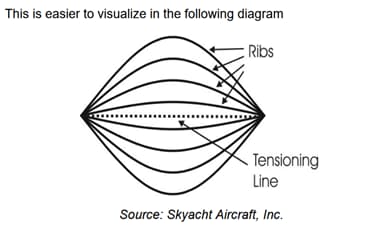
https://lynceans.org/wp-content/uploads/2019/08/Skyacht-Aircraft-_Personal-Blimp-converted.pdf
The specification of the Personal Blimp is as follows:
- Length 102 ft, diameter 70 ft, max weight 4,100 lb, volume 205,000 cu ft
- Propulsion 24-hp gasoline engine, cruise speed 10 mph, steerable propeller

http://www.personalblimp.com/images.html
Advanced Technologies Group (ATG) SkyCat (2006)
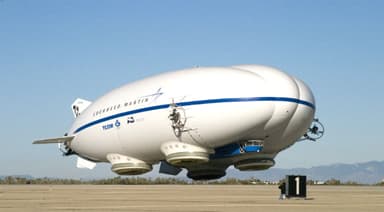
https://militarymachine.com/experimental-aircraft/strange-aircraft-2/
The Sky Catamaran, to give it its full name, was a proposed class of hybrid airships obtaining more than half their lift from helium gas. The balance of the buoyancy came from aerodynamic shaping. A one-sixth scale Sky Kitten version flew at Cardington, Bedford England in 2006. The intention was to develop a class of heavy lifters able to handle up to 1000 pound loads.
The balance of buoyancy required for take off was from propulsive lift by four vectored thrust propulsors. And during forward flight by aerodynamic lift from the shaped fuselage and short wings. However, it was not intended for vertical take-off and landing operations.
It activated a cushion landing system to leave the ground on an air pillow. Thereafter, the propulsion system taxied it to generate sufficient aerodynamic lift for it to fly. It proved able to operate on almost any surface from grass land through swamp to open water.
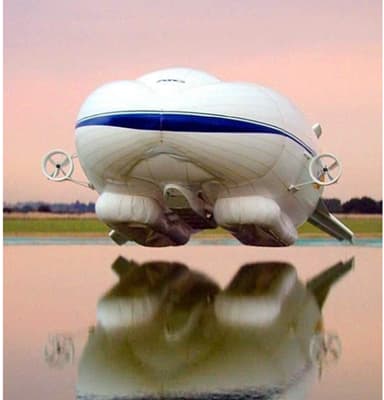
https://www.aerospace-technology.com/projects/skycat
Lockheed Martin P-791 Airship First Flies 2006
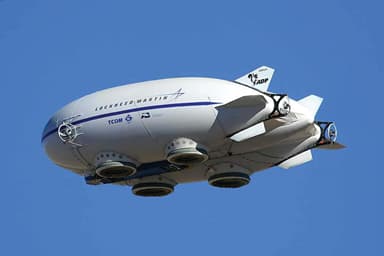
https://www.uas.aero/unique-flying-machines-lockheed-martin-p-791/
The Lockheed Martin P-791 is an experimental airship that combines the energy of aerostatic lift with aerodynamics achieved by movement through the air. It first flew on January 31, 2006, and was intended for military purposes before it failed to secure a military contract.
In June 2015 the company announced it had FAA certification and was open for orders. It would initially have a 20 ton payload, or alternatively carry 19 passengers. The hybrid vessel is slightly heavier than air and hence
- 80% lift comes from buoyant helium in accordance with traditional airship science
- 20% is from hull aerodynamics and vectored thrust from four rotatable engines
- Hovercraft technology creates atmospheric pressure differences for floating above the surface, and gentle landing.
A Kevlar-like material makes up the hull. A self-propelled instrument for damage evaluation and repair (SPIDER) spots and repairs pinhole leaks while the hull remains fully inflated.
Straightline Aviation had ambitious plans in 2020 for everything from cargo and transportation disaster, to relief and humanitarian missions, to aerial surveillance and telecommunications. It spoke of building a $400 million fleet of airships.

https://www.nanalyze.com/2020/07/what-are-airships-future/
Ohio Airships Dynalifter Semi-Buoyant, Hybrid Aircraft (2007)
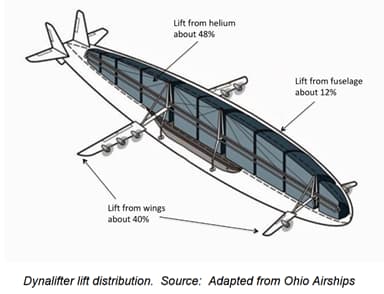
https://lynceans.org/wp-content/uploads/2019/08/Dynalifter-semi_buoyant-aircraft-converted.pdf
The Dynalifter is a counter-flow project in that it attempts to merge lighter-than-air and heavier-than-air flight, and claim the aerodynamic benefits of both.
The design characteristics of the Dynalite are as follows:
- An elongated fuselage containing helium gas cells, with air filling the remainder
- A semi-rigid structure running the length, and supporting wings, control surfaces, landing gear, and gondola for passengers / cargo
- This design enables carrying compact, heavy loads in the cargo hold without risking structural collapse,
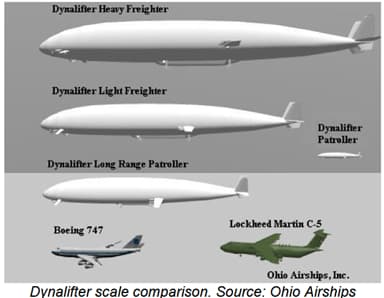
https://lynceans.org/wp-content/uploads/2019/08/Dynalifter-semi_buoyant-aircraft-converted.pdf
Ohio Airships built a 112-foot-long prototype in 2005. It received an Experimental Airworthiness Certificate from the Federal Aviation Administration in July 2006, but suffered damage during thunderstorms.
The rebuilt prototype, Dynalifter DL-100 serves as a 1/10th scale demonstrator for a full-size Dynalifter commercial transport. The company has plans for a passenger version, but is currently working on a drone mothership to deploy and receive delivery drones.
SAIC Skybus 80K (2010)
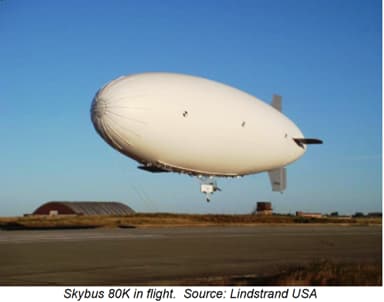
https://lynceans.org/wp-content/uploads/2019/08/SAIC-Skybus-80K-converted.pdf
The Science Applications International Corporation (SAIC) Skybus 80K was a proof-of-concept, non-rigid airship. It demonstrated the ability of a lighter-than-air vehicle to carry a significant load, and set the stage for this important airship role.
Skybus 80K successfully lifted a load of 500 pounds to 10,000 feet for an unbroken 24 hours in 2010. This occasion at Loring Air Force Base in Caribou, Maine was a significant achievement that wrote it into the record books.
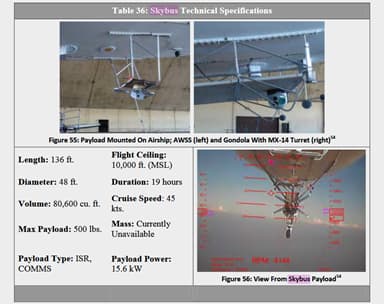
https://www.hsdl.org/?view&did=728733
Worldwide Aeros Corp Dragon Dream Airship 2013
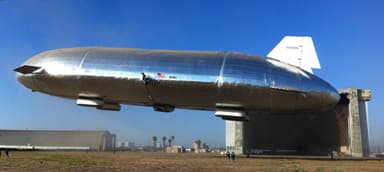
http://aeroscraft.com/aeroscraft/4575666071
The Dragon Dream was an experimental, lighter-than-air rigid cargo airship built to half scale as a prototype. The U.S. government funded the project through Walrus HULA and Pelican program budgets.
Buoyancy control was achieved by moving helium gas between an internal gas bag and a compressed state in helium pressure envelopes (HPEs). This varied the vessel’s lift by 3,000 to 4,000 pounds using ‘control of static heaviness’ principles.

https://lynceans.org/wp-content/uploads/2019/08/Aeros-Aeroscraft-airships-converted.pdf
The specification for the six-crew vessel was as follows:
- Length 266 ft, volume 600,000 cu ft, gross weight 36,000 lb
- Propulsion: 3 Lycoming AEIO-540 SER Reciprocating 260 hp diesels
The Dragon Dream completed in 2013, and obtained an airworthiness certificate from the US Federal Aviation Administration in September that year. It flew for the first time on September 11, 2013. However shortly after that, the hangar collapsed, and the airship was not repaired.
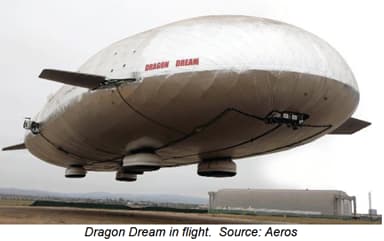
https://lynceans.org/wp-content/uploads/2019/08/Aeros-Aeroscraft-airships-converted.pdf
Millennium Airship SkyFreighter at Concept Stage 2020

http://www.millenniumairship.com/products.htm
SkyFreighter is intended to transport fully-assembled, outsized, and bulky cargo at speeds up to 75 mph. It would have a range of up to 6,000 miles, and be ideal for oil extraction, logging, extended maritime patrols, search and rescue, and medical relief in disaster zones.
The developer envisages a cargo bay up to 288 feet by 60 feet with a 40 foot ceiling. This would be accessed by loading bay doors / ramps at front, rear and side, proportionate to the size of the cargo bay.
Propulsion will comprise four ultra-high efficiency turbo fans in separate engine rooms in the body. These will drive four variable pitch fan assemblies mounted perpendicular to the body of the airship at each thrust wing base.
The thrust wings will direct the flow of air allowing the airship to move forward, back, up and down. This arrangement will enable low-to-zero airspeed maneuvering, including crosswind landing, take-off, and maneuvering. The single vertical stabilizer-rudder will provide most turning direction.
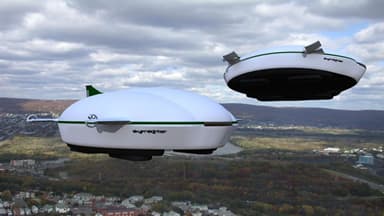
https://www.millenniumairship.com/gallery/
Aero-Nautic Services & Engineering Company A-NSE 2020
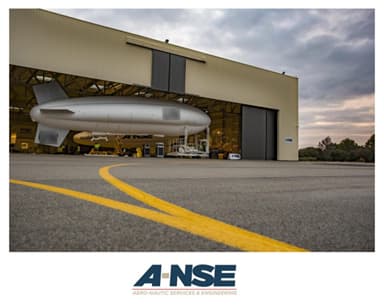
http://www.a-nse.com/pictures/
A-NSE produces airborne surveillance systems installed in airships and tethered balloons in eastern France. It manufactures them for both defense and security, and civil and commercial applications.
Its innovations include an autonomous landing structure, and envelopes with variable shapes and volumes. The former allows landing on any kind of water surface, and remaining afloat. As a result, the company claims a 70% reduction in operating cost, and 20% greater operational availability.
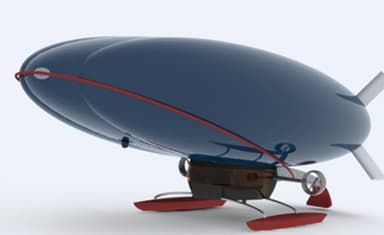
http://www.a-nse.com/portfolio-item/autonomous-landing-structure/
A-NSE proposes the following applications for its airships and tethered balloons:
- Maritime surveillance
- Event security
- Traffic monitoring
- Border surveillance
- Military camp security
- Industrial site protection
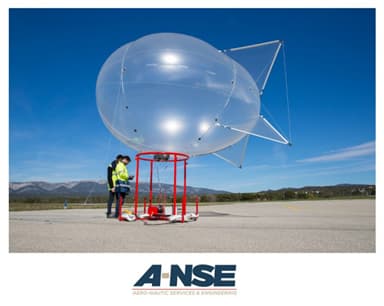
http://www.a-nse.com/pictures/
Flying Whale Airship Project in Progress 2020

https://www.linkedin.com/company/flying-whales/?feedView=images
The French National Forestry Office inspired a new role for airships in its area of responsibility in 2012. This was to deliver large loads to remote forested areas under its jurisdiction, and remove harvested timber. Propulsion would be via renewable energy as far as proves practical.
The prototype aerial vehicle was under testing in 2020, with first flight scheduled for 2021 and commercial production by 2025. Investors include French state fund Bpifrance, which injected € 25 million, China’s state-owned aviation company AVICGeneral, which owns about 25% of Flying Whale, and China’s Ministry Of Science and Technology.

https://www.web24.news/u/2020/07/the-great-comeback-of-the-airship-made-in-france.html
The anticipated specification is as follows:
- Heavy-lift rigid airship with capacity for 132,277 lb load, in-hull or suspended
- Helium lift gas in 10 unpressurized cells within frame, and in outer hull
- Internal load bay 262 ft x 26 ft x 16 ft high
- Hybrid propulsion system comprising:
- Ø Small diesel generator
- Ø Graphene-based fast charging ultra-capacitors
- Ø Seven electrically-powered propulsors
- Cargo collection and delivery using winches, tethering not required
- Crew 3, maximum range 620 miles, operational trips under 60 miles

https://www.businessinsider.com/flying-whales-lca60t-airship-can-move-cargo-without-landing-2020-9?IR=T#as-of-now-the-price-of-the-aircraft-is-confidential-but-according-to-the-flying-whales-team-its-tag-is-closer-to-that-of-a-helicopter-than-a-plane-3



